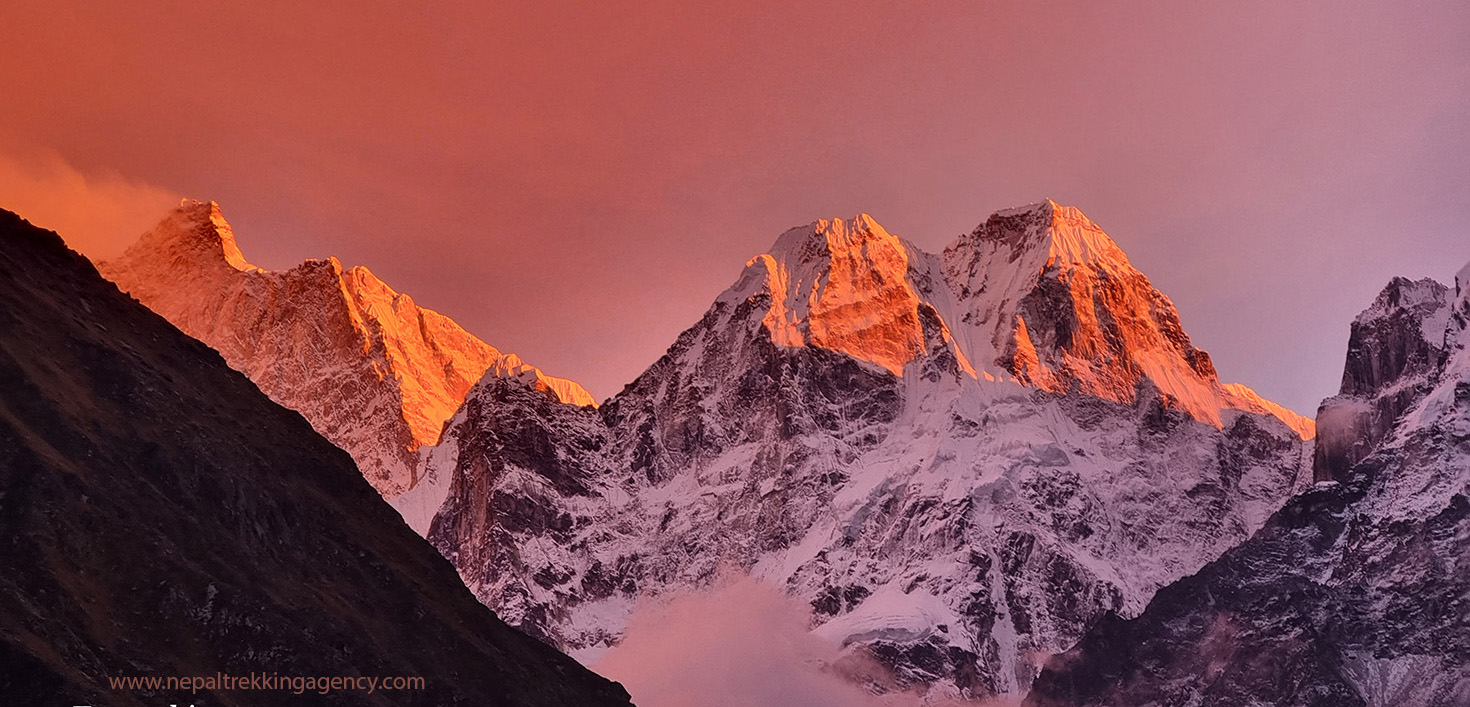
Kanchenjunga Trek
Kanchenjunga Trek – Kanchenjunga, proudly standing as the world’s third-highest mountain at 8,586 meters (28,169 feet), graces the eastern Himalayas, straddling the border between Nepal and the Indian state of Sikkim. Its Tibetan name, “Five Treasures of Snow,” encapsulates its grandeur with five distinct massif mountain peaks:
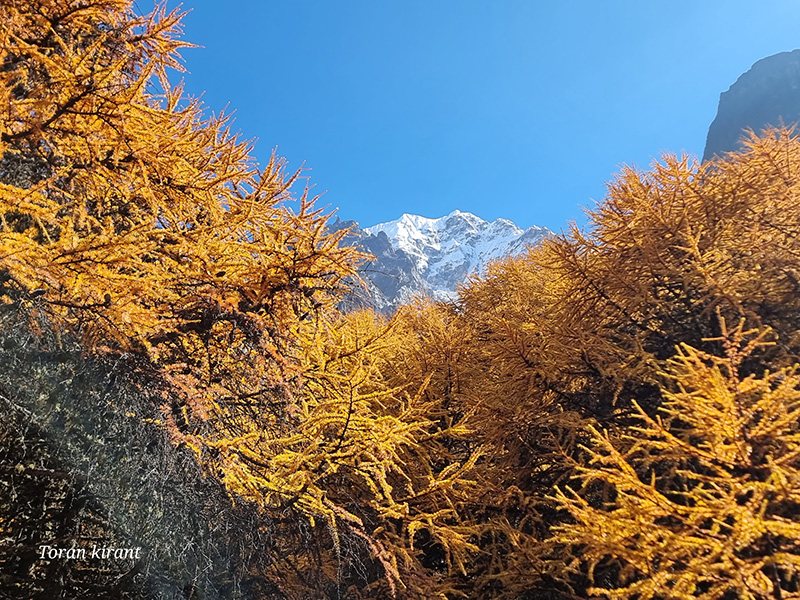
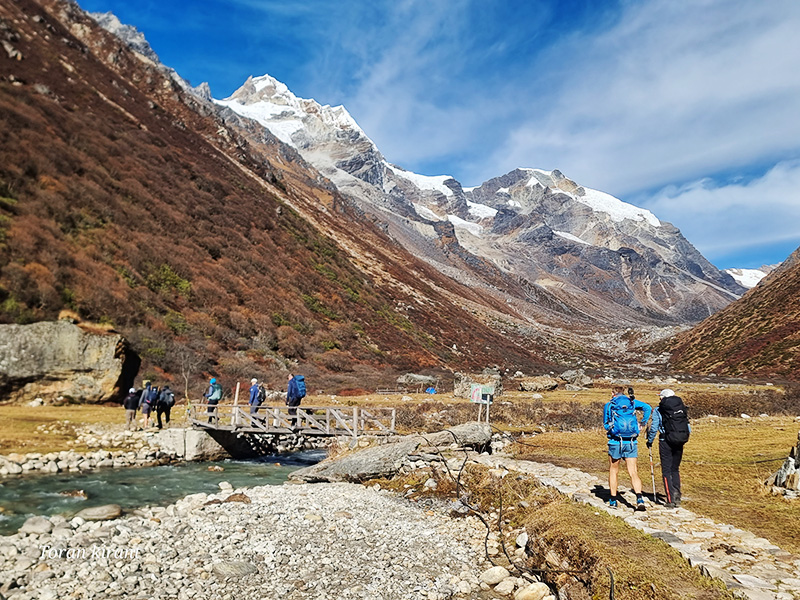
Kanchenjunga Main (Central): The highest peak, globally ranked third at 8,586 meters (28,169 feet).
Kanchenjunga West (Yalung Kang): The second-highest peak at 8,505 meters (27,903 feet).
Kanchenjunga South (Yonjan): The third-highest peak at 8,494 meters (27,867 feet).
Kanchenjunga Central: The fourth-highest peak at 8,482 meters (27,828 feet).
Kanchenjunga North: The lowest peak at 7,710 meters (25,296 feet).
Embarking on the Kanchenjunga trek guides you through diverse landscapes, commencing from lowland areas adorned with lush subtropical forests, captivating villages, and terraced fields, to vibrant rhododendron and oak forests. The region unfolds its rich biodiversity, showcasing a variety of bird species and wildlife.
As you ascend into the middle hills, rhododendron and magnolia forests greet you, accompanied by rugged terrain, river crossings, and magnificent valleys. The villages in this region celebrate the unique cultures and traditions of ethnic groups, including the Rai, Limbu, and Sherpa communities.
Higher altitudes introduce alpine meadows where yaks graze against a backdrop of picturesque settlements. The landscape opens up, presenting panoramic views of surrounding mountains. Approaching the Kanchenjunga base camps brings forth challenges such as glacial moraines and high mountain passes, with weather conditions proving unpredictable. The effort is duly rewarded with awe-inspiring views of towering peaks like Yalungkhang, Kumbakarna, and the majestic Kanchenjunga itself.
The Kanchenjunga trek unfolds progressively, beginning at the southwest base camp of Pangpema. Crossing the Silala Pass, the journey continues to the Kanchenjunga South Base Camp, following the conventional route. Beyond the immersive experience in the cultural tapestry of local communities, the trek offers an opportunity to savor the breathtaking natural beauty of the Himalayas, complemented by unparalleled mountain vistas.
“To walk in nature is to witness a thousand miracles.” By Mary Davis
Table of Contents
- Kanchenjunga Trek Major Highlights
- How To Get There?
- Kanchenjunga Trekking Cost
- The Best Time For Kanchenjunga Trek
- Food And Accommodation On Kanchenjunga Trek
- How Difficult Is Kanchenjunga Trek
- People And Culture Of Kanchenjunga Trekking Region
- Why Kanchenjunga Trekking Is A Rewarding Experience
- What To Pack For Kanchenjunga Trek
- Wildlife And Vegetation In Kanchenjunga Trek
Kanchenjunga Trek Major Highlights
The Kanchenjunga trek unfolds a myriad of highlights, offering trekkers a unique and rewarding experience. Here are some major highlights of the Kanchenjunga trek:
Third-Highest Mountain: Witness the majestic beauty of Kanchenjunga, the world’s third-highest mountain, standing at an elevation of 8,586 meters (28,169 feet).
Cultural Diversity: Immerse yourself in the rich cultural tapestry of the region as you traverse through villages inhabited by diverse ethnic communities, including Sherpas, Rai, Limbu, and Gurung.
Flora and Fauna: Explore the diverse flora, including lush subtropical forests, rhododendron-filled landscapes, and alpine meadows. Encounter rare wildlife such as the red panda, snow leopard, black bear, and various bird species.
Kanchenjunga Conservation Area: Trek through the Kanchenjunga Conservation Area, recognized as a Global Eco-region by the World Wildlife Fund, and witness its efforts in preserving the unique biodiversity of the region.
Remote and Less-Visited Trails: Experience the tranquility of less-explored trails, offering a sense of solitude and serenity amid the Himalayan wilderness.
Challenging High Passes: Conquer challenging high passes like Sele Le Pass and Mirgin La, offering spectacular panoramic views of the surrounding mountains.
Kanchenjunga Base Camps: Reach the base camps of Kanchenjunga, including Pang Pema (North Base Camp) and Kanchenjunga South Base Camp, to enjoy unparalleled views of the towering peaks.
Cultural Interaction: Engage with local communities, learn about their unique customs and traditions, and savor the local cuisine, adding a cultural dimension to your trek.
Picturesque Landscapes: Marvel at the ever-changing landscapes, from terraced fields and dense forests to alpine meadows and glacial moraines, creating a visual feast for trekkers.
Off-the-Beaten-Path Adventure: Embark on an off-the-beaten-path adventure, away from the crowded trekking routes, providing a more intimate and authentic Himalayan experience.
The Kanchenjunga trek is a blend of natural beauty, cultural richness, and physical challenge, making it a memorable and rewarding journey for trekking enthusiasts.
How to get there?
Many Kanchenjunga treks commence from Taplejung, near Suketar airport. However, this airport’s elevated location often leads to flight cancellations or delays due to adverse weather conditions. To circumvent potential disruptions, we recommend taking a flight to Bhadrapur and then driving to Taplejung or alternative starting points such as Sukethum or Mitlung.
Alternatively, for those with ample time and an adventurous spirit, a road trip from Kathmandu to Taplejung and back is an option. This journey can be undertaken via local buses or private jeeps, although it necessitates additional days. Despite the extended travel time, it presents an ideal choice for those seeking a scenic road trip and can result in cost savings, especially for group travelers.
Kanchenjunga Trekking Cost
The Kanchenjunga trek entails mandatory expenses such as hiring a guide, obtaining trekking permits, managing pricey domestic flights, and enduring extended trekking days in the remote corners of the Himalayas. This can render it a comparatively more expensive venture compared to other treks in Nepal.
Furthermore, the overall cost of Kanchenjunga trekking is influenced by various factors including the level of service, type of accommodation, duration of the trek, specific itinerary, and more. Generally, encompassing all these aspects in comprehensive packages, the cost is expected to range from a minimum of USD 2000 to 3500 per person. The expense is justified by the serene trail, breathtaking scenery, and the opportunity to immerse in the unique local culture, making the Kanchenjunga trek a worthwhile investment.
The best time for Kanchenjunga Trek
The optimal periods for Kanchenjunga Trekking are Spring (March, April, May) and Autumn (September, October, November). During these seasons, the weather and temperatures are most favorable, ensuring a comfortable trekking experience.
While Kanchenjunga Trekking is feasible throughout the year, the monsoon season (June to August) introduces challenges due to frequent rainfall, making the trails complex and potentially hazardous. In winter, the region experiences extremely cold conditions. While trekking during the off-seasons is possible, it comes with increased difficulty and is not as recommended for those seeking a more comfortable and enjoyable trekking adventure.
We strongly recommend undertaking this trek during autumn and spring for several compelling reasons:
Alluring Mountain Vistas: Revel in captivating views of Mt. Kanchenjunga (8,586m), Kangbachen (7,902m), Mt. Kumbhakarna/Jannu Peak (7,710m), and more.
Minimal Rainfall: The absence of rainfall minimizes the risk of wet and slippery trails and potential landslides.
Stable Weather Conditions: Enjoy favorable weather with stable temperatures.
Spring Splendor: The spring season adorns the trail with a vibrant ambiance, featuring lush forests, green vegetation, and colorful flowers.
Uncrowded Trails: Despite being a peak trekking season, the isolated nature of the route ensures the trail remains uncrowded.
Food and Accommodation on Kanchenjunga Trek
As the Kanchenjunga trail is still in the process of development as a teahouse trek in Nepal, it’s advisable not to set exceedingly high expectations. Accommodations encountered along the trek are generally decent, providing more basic facilities. Even in remote villages at higher elevations, such as Pang Pema and Ramche, there may be only one or two places to stay, and bathroom facilities may require showering with a bucket of water.
The cost of food tends to be higher compared to more established trekking regions like Everest or Annapurna. Nevertheless, you can expect ample and nourishing meals along the trail. Most teahouses offer a similar food menu, which might lead to a degree of monotony. Additionally, there are limited hotels or shops along the route, so it’s advisable to carry chocolates, energy bars, and snacks to ensure you stay well-fueled during your trek.
How difficult is Kanchenjunga Trek
The Kanchenjunga Trek is known for its challenging difficulty level, as it is considered one of Nepal’s longest, most remote, and highest-altitude treks. The trek starts at an elevation of 91 meters in Bhadrapur and goes up to 5,143 meters at Pang Pema (North Base Camp). Throughout the trek, you will encounter different elevations, which can lead to unpredictable weather conditions including changes in temperature, air pressure, and humidity.
This trek takes you through remote and less-traveled terrain, which is mostly rocky. As a result, some days can be physically challenging. It is essential to prioritize maintaining a high level of fitness. One effective way to achieve this is by participating in outdoor sports like hiking, running, swimming, and cycling. These activities can greatly contribute to your overall physical preparedness.
Trekking at altitudes above 3,000 meters carries the risk of developing Acute Mountain Sickness (AMS), also known as altitude sickness. Listening to your body, proceeding at your own pace, and staying adequately hydrated are all essential. It is advisable to seek advice from your family doctor regarding your health and fitness.
Although the Kanchenjunga Circuit trek is challenging, prior trekking experience is not required. Individuals who are physically fit can undertake and successfully complete this trek with sufficient preparation and time.
Here are some factors contributing to its difficulty:
High Altitude: The trek reaches high altitudes, with Pang Pema (North Base Camp) situated at 5,143 meters (16,873 feet). Altitude-related challenges such as Acute Mountain Sickness (AMS) can occur.
Remote and Off-Beaten Path: The trail is less developed compared to more popular trekking routes like Everest or Annapurna. It traverses remote and isolated regions where facilities may be basic.
Unpredictable Weather: Weather conditions can be unstable, with fluctuations in temperature, air pressure, and humidity. The trail’s remoteness adds to the challenge of predicting and dealing with weather changes.
Rocky Terrain: The trek involves walking on rocky terrain for a significant portion, making certain sections physically demanding.
Long Duration: Kanchenjunga Trek is a lengthy trek that spans several weeks, requiring endurance and stamina.
Altitude Sickness Risk: Trekking above 3,000 meters poses a risk of altitude sickness, and trekkers need to be cautious and follow proper acclimatization practices.
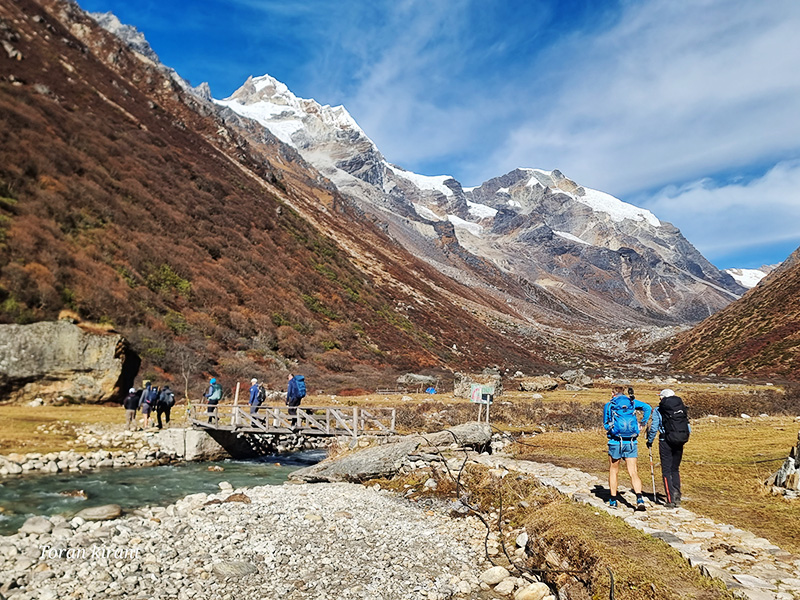
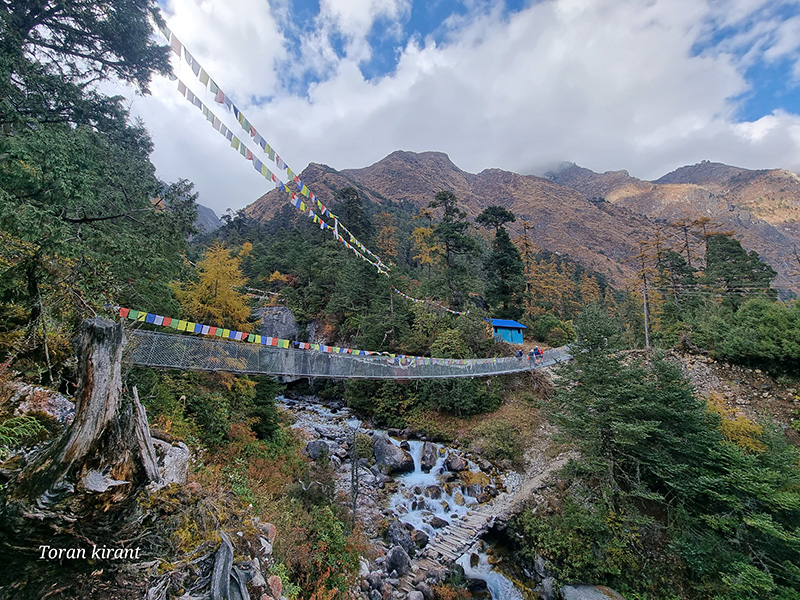
People And Culture Of Kanchenjunga Trekking Region
The Kanchenjunga trek in Nepal provides a unique combination of venturing off the usual tourist routes and immersing oneself in the local culture of the remote Himalayan region. The region is inhabited by a wide range of ethnic groups, such as Sherpas, Tamangs, Rai, Limbu, and Lepchas. Buddhism is the predominant religious practice, although there are also various other traditions that coexist. The cultural tapestry and lifestyle primarily reflect Tibetan influences.
The majority of the local population is involved in agriculture, which adds to the peaceful atmosphere of the region. During the journey to Ghunsa, travelers are greeted by the sight of picturesque terraced fields, beautifully adorned with various crops including wheat, barley, potatoes, and buckwheat. The captivating allure of terrace farming graces the mountain slopes. Moreover, a significant number of people in this distinctive and culturally diverse region rely on the service sector for their livelihoods.
Why Kanchenjunga Trekking is a Rewarding Experience:
Remote and Less-Visited Trails: The eastern part of Nepal offers trekking through remote and less-explored trails, providing a unique and off-the-beaten-path experience.
Cultural Diversity: Kanchenjunga boasts rich cultural diversity, with the trek taking you through regions inhabited by ethnic communities like Limbu, Rai, Sherpa, and Gurung.
Breathtaking Mountain Views: Enjoy awe-inspiring views of the world’s third-highest peak, Kanchenjunga, along with other majestic Himalayan peaks such as Jannu, Kabru, and Rathong.
Scenic River Crossings: Traverse strong and meandering rivers, including the Arun River, Ghunsa Khola, and Simbuwa Khola, adding an adventurous element to the trek.
Dense Forests and Wildlife: Trek through dense forests of rhododendrons, oaks, and magnolias, offering opportunities to spot elusive wildlife like the snow leopard, red-billed blue magpie, red panda, Himalayan black bear, and musk deer.
Cultural Immersion: Immerse yourself in the unique customs, traditions, and daily life of the local communities, gaining insights into their rich cultural tapestry.
Local Cuisine: Indulge in the local cuisine with delicious dishes such as momos, thukpa, and dal-bhat, enhancing the overall cultural experience.
Perfect Blend of Beauty and Challenge: Kanchenjunga Trek offers a perfect combination of natural beauty, cultural diversity, and a physical challenge, making it an enriching adventure.
For Experienced Trekkers: Ideal for experienced trekkers seeking a new adventure, the trek explores less-visited trails and provides a unique perspective on Nepal’s diverse landscapes.
Mystery and Folklore: The Kanchenjunga region is shrouded in mystery, with legends of sightings of the Himalayan Yeti. Yeti is a prominent subject of local folklore and stories, adding an element of intrigue to the trekking experience.
What to pack for Kanchenjunga Trek
Packing for the Kanchenjunga Trek requires careful consideration to ensure you’re well-prepared for the challenging terrain and varying weather conditions. Here’s a comprehensive list of items to pack:
Clothing: Dress in layers with warm base layers, fleece jackets, waterproof outerwear, gloves, a hat, and a scarf.
Footwear: Sturdy hiking boots, wool socks, and gaiters for trekking comfort.
Sleeping Gear: Warm sleeping bag with a -10°C rating and a sleeping pad for a comfortable night’s rest.
Backpack: A sturdy backpack with a waist belt and 50-60L capacity for carrying essentials.
Trekking Poles: Reduce impact and improve balance during the trek.
Water: Water bottle and water treatment tablets or a filtration system for clean water consumption.
Illumination: Headlamp or flashlight for navigating in low-light conditions.
First Aid Kit: Include bandages, painkillers, anti-diarrhea medication, and personal medications for emergencies.
Sun Protection: Sunscreen, sunglasses, and a hat to shield yourself from the Himalayan sun.
Snacks: High-energy snacks like trail mix, energy bars, and chocolate for quick boosts of energy.
Shelter: A sturdy, lightweight tent is essential for camping during the trek.
Cooking Equipment: Portable stove, fuel, and cooking utensils for preparing meals on the trek.
Hydration System: A hydration pack or water bottles with insulating covers to prevent freezing at higher altitudes.
Navigation Tools: Map, compass, and GPS device to help navigate the trekking route accurately.
Emergency Equipment: Whistle, signal mirror, and emergency blanket for unexpected situations.
Toiletries: Toothbrush and toothpaste, hand sanitizer, wet wipes, and a quick-drying towel for personal hygiene.
Wildlife and Vegetation in Kanchenjunga Trek
The Kanchenjunga Trek takes you through a captivating journey, showcasing a diverse landscape and vegetation. Starting from the lowlands of Terai, the trek gradually leads you through coniferous forests, grasslands, and meadows. The diverse vegetation found in this area not only adds to its scenic beauty, but also provides a habitat for a wide range of wildlife.
The Kanchenjunga Conservation Area, acknowledged as a Global Eco-region by the World Wildlife Fund, is famous for its diverse range of rare species. These include the elusive snow leopard, black bear, musk deer, and vibrant red pheasant.
During autumn, nature treats us to a magnificent display of vibrant colors as thirty different varieties of rhododendron and sixty-nine varieties of orchids grace the trails, creating a breathtaking spectacle. The trekking experience is further enhanced by the enchanting sounds of birds and wildlife.
At lower altitudes, the trek leads you through dense forests of pine, fir, bamboo, and hemlock. As you climb to higher altitudes in the Kanchenjunga region, you’ll notice a decrease in the occurrence of Pines and Junipers. This scarcity adds to the dynamic and distinctive environment found in the area.









